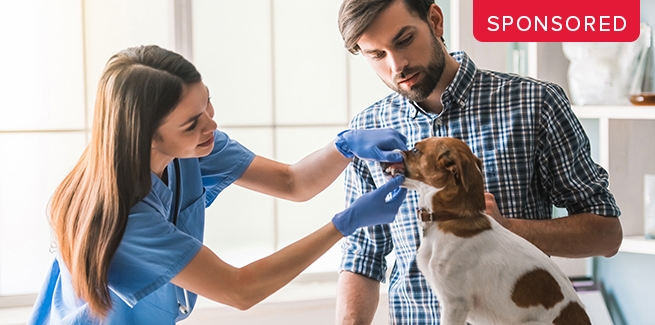Getting to the root of better dental care for pets

A Q&A interview with Mary Berg, BS, RVT, RLATG, VTS (Dentistry)
Despite evidence about the serious consequences of periodontal disease on a pet's health, many pet owners are unaware of the importance of preventive dental care throughout a pet's life. In fact, dental disease can start early in life.1 So how can we help more pets get the lifetime of dental care, diagnostics and treatment they need? The CareCredit team asked veterinary dental consultant and instructor Mary Berg, RVT, VTS (Dentistry), a charter member of the Academy of Veterinary Dental Technicians, to share a few insights based on her experience.
Q. The language we use with clients may impact how they respond to dental recommendations for their pets. What phrases/words work most effectively?
For starters, make sure everyone on the team understands periodontal disease, can communicate with clients clearly, and uses appropriate definitions. We need to remember our clients may not understand phrases like “periodontal therapy” or “Comprehensive Oral Health Assessment and Treatment (COHAT).”
If we say, “Your dog has periodontal disease,” clients might give us a blank stare. But when we say, “Your dog has an infection in his mouth,” they’ll probably understand very quickly and agree an infection is something serious that needs to be treated. When I explain that all the infected gingival tissue from a standard poodle would be about the size of the palm of my hand, pet owners cringe. But since it’s under the lip, they haven’t seen it or realized the consequences.
Q. What are the best ways to present a pet’s dental treatment plan and prepare clients for the cost?
I sit down with the pet owner when I’m discussing the treatment plan. I go over the plan line by line and explain the need for each item (e.g., radiographs, preanesthetic blood work).
The total price is usually at the bottom, and I cover this with my hand until we’ve gone down the entire list. By the time I uncover the total price, they’ve seen and understood each item. When they know the total cost, I step out of the room and tell them I’ll be back if they have any questions. When I return, I try to schedule the appointment. Even if they aren’t sure, we can put a date down and assure them they can call back once they've checked their calendars.
Either the receptionist or the veterinary technician can take a lead role in discussing any concerns about costs and explaining available payment options.
Offering payment options can make a big difference and allow clients to help their pet even if funds are not immediately available. For example, many practices offer a healthcare credit card that allows clients to pay over time so they can move ahead with healthy oral care for the pets they love.
Want to read the entire article? If you're enrolled in CareCredit, call your CareCredit team at
800-859-9975, option 1 , then 6. To enroll, call 877-384-1294
___________________________________
1. 10 things you need to know about AAHA's Dental Care Guidelines, www.aaha.org/guidelines/dental_guidelines.
This information is shared solely for your convenience. All statements are the sole opinions of Mary Berg. Neither Synchrony nor any of its affiliates, including CareCredit, make any representations or warranties regarding this content.



